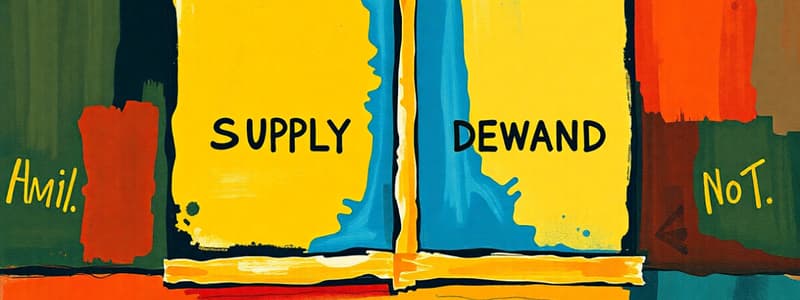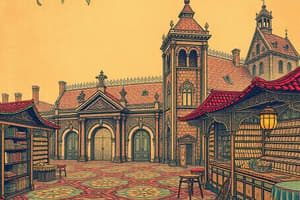Podcast
Questions and Answers
Which of the following scenarios best illustrates a microeconomic concept?
Which of the following scenarios best illustrates a microeconomic concept?
- A study on how a local bakery determines the price of its cupcakes. (correct)
- The impact of a new tax policy on overall economic growth.
- An increase in the national unemployment rate due to a recession.
- The effect of government spending on the country's GDP.
In a perfectly competitive market, if demand for a product increases and supply remains constant, what is the most likely outcome?
In a perfectly competitive market, if demand for a product increases and supply remains constant, what is the most likely outcome?
- The market price will increase, and the quantity supplied will increase. (correct)
- The market price will remain constant, and the quantity supplied will increase.
- The market price will decrease, and the quantity supplied will decrease.
- The market price will decrease, and the quantity supplied will increase.
Which market structure is characterized by a few firms dominating the industry?
Which market structure is characterized by a few firms dominating the industry?
- Perfect competition
- Monopolistic competition
- Monopoly
- Oligopoly (correct)
A factory emitting pollutants into the air, affecting the health of nearby residents, is an example of what economic concept?
A factory emitting pollutants into the air, affecting the health of nearby residents, is an example of what economic concept?
Which of the following is the best example of a public good?
Which of the following is the best example of a public good?
Which macroeconomic variable is used to measure the total value of goods and services produced within a country's borders?
Which macroeconomic variable is used to measure the total value of goods and services produced within a country's borders?
What is the likely result of expansionary fiscal policy?
What is the likely result of expansionary fiscal policy?
If the price elasticity of demand for a good is 2.5, what does this indicate about the demand for that good?
If the price elasticity of demand for a good is 2.5, what does this indicate about the demand for that good?
Which of the following scenarios best illustrates the concept of moral hazard?
Which of the following scenarios best illustrates the concept of moral hazard?
In a mixed economy, what is the primary role of government intervention?
In a mixed economy, what is the primary role of government intervention?
Which of the following policies aligns with supply-side economics?
Which of the following policies aligns with supply-side economics?
If a country can produce cloth at a lower opportunity cost than another country, what economic concept does this demonstrate?
If a country can produce cloth at a lower opportunity cost than another country, what economic concept does this demonstrate?
What is the likely impact of a central bank lowering interest rates?
What is the likely impact of a central bank lowering interest rates?
Which of the following is the best example of adverse selection in the health insurance market?
Which of the following is the best example of adverse selection in the health insurance market?
What is the primary goal of Keynesian economic policy during a recession?
What is the primary goal of Keynesian economic policy during a recession?
Which of the following is NOT typically considered a key indicator of economic performance?
Which of the following is NOT typically considered a key indicator of economic performance?
What is the main focus of policies designed to promote economic development?
What is the main focus of policies designed to promote economic development?
Which of the following trade policies would MOST LIKELY be implemented to protect domestic industries from foreign competition?
Which of the following trade policies would MOST LIKELY be implemented to protect domestic industries from foreign competition?
Flashcards
Economics
Economics
The allocation of limited resources to fulfill unlimited wants and needs.
Microeconomics
Microeconomics
Focuses on individual economic agents like households, firms, and markets.
Supply
Supply
The quantity producers offer at various prices.
Demand
Demand
Signup and view all the flashcards
Market equilibrium
Market equilibrium
Signup and view all the flashcards
Elasticity
Elasticity
Signup and view all the flashcards
Macroeconomics
Macroeconomics
Signup and view all the flashcards
Fiscal Policy
Fiscal Policy
Signup and view all the flashcards
Monetary Policy
Monetary Policy
Signup and view all the flashcards
Business Cycles
Business Cycles
Signup and view all the flashcards
Economic Growth
Economic Growth
Signup and view all the flashcards
Economic Systems
Economic Systems
Signup and view all the flashcards
Economic Development
Economic Development
Signup and view all the flashcards
GDP Growth Rate
GDP Growth Rate
Signup and view all the flashcards
Opportunity Cost
Opportunity Cost
Signup and view all the flashcards
Comparative Advantage
Comparative Advantage
Signup and view all the flashcards
Economies of Scale
Economies of Scale
Signup and view all the flashcards
Moral Hazard
Moral Hazard
Signup and view all the flashcards
Study Notes
- Economics is a social science that studies how societies allocate scarce resources to satisfy unlimited wants and needs.
- It examines the production, distribution, and consumption of goods and services.
- Economic analysis is applied throughout society, in business, finance and government.
Microeconomics
- Microeconomics focuses on the behavior of individual economic agents, such as households, firms, and markets.
- It analyzes how these agents make decisions in the face of scarcity and how their interactions determine prices and quantities in specific markets.
- Supply and demand are fundamental concepts, where supply represents the quantity of a good or service that producers are willing to offer at various prices, and demand represents the quantity that consumers are willing to purchase at different prices.
- Market equilibrium is the point where supply and demand intersect, determining the market price and quantity.
- Elasticity measures the responsiveness of one variable to a change in another, such as the price elasticity of demand, which measures how much the quantity demanded changes in response to a change in price.
- Market structures include perfect competition (many firms, homogeneous products), monopoly (one firm), oligopoly (few firms), and monopolistic competition (many firms, differentiated products).
- Game theory analyzes strategic interactions between economic agents, especially in oligopolistic markets.
- Externalities are costs or benefits that affect parties not involved in a transaction, like pollution (negative externality) or education (positive externality).
- Public goods are non-excludable and non-rivalrous, meaning that it is difficult to prevent people from consuming them and one person's consumption does not diminish another's (e.g., national defense).
Macroeconomics
- Macroeconomics studies the behavior of the economy as a whole, focusing on aggregate variables such as GDP, inflation, and unemployment.
- GDP (Gross Domestic Product) measures the total value of goods and services produced within a country's borders during a specific period.
- Inflation is the rate at which the general level of prices for goods and services is rising, and subsequently, purchasing power is falling.
- Unemployment refers to the percentage of the labor force that is actively seeking employment but unable to find it.
- Fiscal policy involves government spending and taxation policies to influence the economy.
- Monetary policy involves actions taken by a central bank to manipulate the money supply and credit conditions to stimulate or restrain economic activity.
- Business cycles are fluctuations in economic activity, characterized by periods of expansion (growth) and contraction (recession).
- Economic growth refers to the increase in the production of goods and services in an economy over time, typically measured by the percentage change in real GDP.
- Aggregate supply and aggregate demand are used to analyze the overall price level and output in the economy.
- International trade analyzes the exchange of goods and services between countries.
- Exchange rates determine the value of one currency in terms of another.
Economic Systems
- Economic systems refer to the way a society organizes the production, distribution, and consumption of goods and services.
- A market economy relies on decentralized decision-making by individuals and firms, with prices determined by supply and demand.
- A planned economy relies on centralized decision-making by the government, with the government controlling resource allocation.
- A mixed economy combines elements of both market and planned economies, with government intervention to address market failures and promote social welfare.
Economic Development
- Economic development focuses on improving the standard of living and quality of life in a country.
- It includes economic growth, but also encompasses improvements in health, education, and other social indicators.
- Factors influencing economic development include human capital, natural resources, capital accumulation, and technological progress.
- Trade policies, foreign aid, and institutional reforms can play a role in promoting economic development.
Key Economic Indicators
- GDP growth rate reflects the percentage change in GDP from one period to another.
- Inflation rate measures the percentage change in the price level from one period to another.
- Unemployment rate indicates the percentage of the labor force that is unemployed.
- Interest rates are the cost of borrowing money, usually expressed as an annual percentage.
- Exchange rates indicate the value of one currency in terms of another.
- Consumer confidence measures the degree of optimism that consumers feel about the overall state of the economy and their personal financial situation.
Economic Theories
- Classical economics emphasizes the importance of free markets and limited government intervention.
- Keynesian economics emphasizes the role of government intervention in stabilizing the economy, especially during recessions.
- Monetarism emphasizes the role of money supply in influencing economic activity and inflation.
- Supply-side economics focuses on policies to increase aggregate supply, such as tax cuts and deregulation.
- Behavioral economics incorporates psychological insights into economic models to better understand decision-making.
Economic Policy
- Fiscal policy involves government spending and taxation to influence the economy.
- Monetary policy involves central bank actions to control the money supply and credit conditions.
- Trade policy involves tariffs, quotas, and other regulations that affect international trade.
- Regulatory policy involves government rules and regulations that affect business activity and consumer welfare.
- Environmental policy involves regulations and incentives to protect the environment and address climate change.
Economic Concepts
- Opportunity cost is the value of the next best alternative that is forgone when making a decision.
- Comparative advantage is the ability to produce a good or service at a lower opportunity cost than another producer.
- Economies of scale refer to the cost advantages that a firm obtains due to its scale of operation.
- Moral hazard occurs when one party has an incentive to take undue risks because the costs are not borne by that party.
- Adverse selection occurs when one party has information that is not available to the other party in a transaction.
Studying That Suits You
Use AI to generate personalized quizzes and flashcards to suit your learning preferences.




